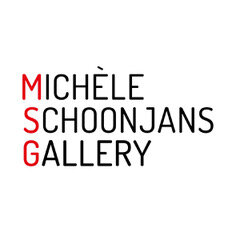Jérôme Bouchard détail Biais n°2, 2024, acrylic on Canvas
Jérôme Bouchard
on n’y voit rien : tout de suite
08.09 > 26.10.24
With what sense of irony does a visual artist announce to the viewer in the opening of his exhibition that “we see nothing” ?
Of course, challenging ourselves about what an image depicts - in itself a constant reminder of Magritte’s painting "ceci [still] n’est pas une pipe” - “has been and remains" the essence of modern painting. Bouchard's work is no exception to this question, but for him this question is not only the subtext of his work: it is integrated into the fabric of the work, in the layers of which it is composed.
Let me explain. His paintings, often begin with a "cloud of points", the graphic translation of the analysis of a given site generated by the geomatic equipment known by the acronym LIDAR (Light Detection & Ranging). Despite the nebulous metaphor that should make us stop and think, LIDAR is an essential tool in today’s management decision making. The tool is supposed to produce an objective view of our environment, even if certain features of our environment - wasteland, watercourses, etc. - end up creating voids, inaccuracies and "data trails”. This is where the painter steps in and takes over. Without him, in short, we see nothing, we perceive nothing of the sensitive experience of the country, that is to say of the landscape. So much so that one is reminded of the famous quote by the art historian Ernst Gombrich about LIDAR: “the innocent eye is a myth... “ .
The title of a book “On n’y voit rien” (“we see nothing in it”) can be traced back to another art historian, Daniel Arasse. This short phrase invites us to focus on the work of art itself rather than any art commentary if we are finally to "see something" - hence the subtitle, Descriptions. Describing his work is far from simple as Bouchard excels in cultivating the indistinct. It’s looks like a landscape: there are skies, clouds, vegetation, ferns, mudflows and heavenly stars. It reminds one of Victor Hugo's romantic landscapes of spent coffee grounds, or the jagged landscapes of the baroque Hercule Seghers: "Lava, mud, trees like rags and pebble stones. 1”
But unlike these two glorious ancestors, Bouchard does not compose imaginary landscapes- quite the contrary. Not only do many of his landscapes derive from indisputable computer syntheses, but they have their roots in time and space. Bouchard adds to the stratigraphy of it all by being an uprooted Canadian living in Belgium. Each of these recordings focuses on an identified space, close to the places where he has lived. He chooses Belgian linen canvas, which has a heavy physical characteristic and dates back to a long history of Western painting. Born in Belgium, Van Eyck, the founding father of Western painting, taught us how metaphysics can be anchored in the here and now. In a different moment in history, as if symmetrically, the painter of the Anthropocene faces another “representation challenge”. As Bouchard says: figuring out the impact of the industrial activity that defines its era, on human beings and environments. How can painting make us see this?
While Bouchard's work integrates the long timeframe of geology, it also requires meticulousness and plenty of time from the viewer because "you can't see anything" immediately, says the painter. It was once said "art is long", both in the making and in contemplation. In Bouchard's work, the question of 'doing' is central to reconciling so many physical and temporal factors. To transcribe the "data fog", he implements solutions innovative and improbable technical solutions that go so far as to micro-perforating the canvas. He also knows how to paint as a meditative process. And so, applying his subtle glazes, illuminating the back of the canvas with colour, the painter proceeds by successive ‘mise en abîme’, discards and imperceptible shifts. In the end, the painting imposes itself with a kind of sovereign and, yes, joyful clarity.
Yves Randaxhe, July 2024
Jérôme Bouchard would like to thank Pierre Hallot, Professor and geomatician at the University of Liège, Bryan Stepien and Amélie Dor (Relab, Liège) and Technifutur (Seraing) for their invaluable support.
______________
1 Carl Einstein, (Engravings by Hercule Seghers, in Documents: doctrines, archaeology, fine arts, ethnography, 1929, (p. 291-297).















